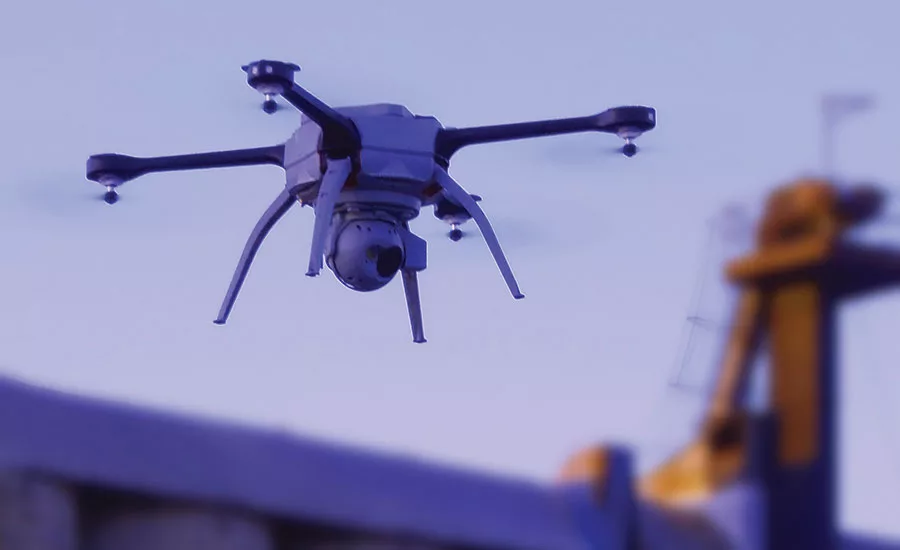Roofing Contractors: The FAA Wants to Track Your Drone

On Dec. 31, 2019, the Federal Aviation Administration (FAA) published “The Remote ID Notice of Proposed Rulemaking (NPRM).” According to a posting on the FAA website, www.faa.gov, “The Remote Identification proposed rule provides a framework for remote identification of all UAS (unmanned aerial systems) operating in the airspace of the United States. The rule would facilitate the collection and storage of certain data such as identity, location, and altitude regarding an unmanned aircraft and its control station.”
The publication of the NPRM started the clock on a 60-day period for public comments. I’m not going to get into all the details, which are numerous, but will simply share with you that I’m concerned about this new remote identification rule as it relates to roofing contractors operating UAS (also referred to as drones).
While the FAA cites safety and security as the key motivations for establishing new rules for small unmanned aircraft operating in the nation’s airspace, they’re lacking in hard data to demonstrate that there’s a problem. I do know for a fact, however, that using UAS for making measurements and roof inspections is far, far safer than climbing ladders and walking roofs.
The new rules, which are also said to be needed to enable “beyond visual line of sight” (BVLOS) flights and unmanned aerial delivery services, will make it very difficult for small individual operators, such as your roofing business, to operate a UAS. It will require an Internet connection to your UAS and that UAS will have to be equipped to transmit its location (geo-location, altitude, etc.) to the FAA or its authorized agents.
In my opinion, making rules for the emerging uses for BVLOS shouldn’t require remote identification for virtually everything flying in the commercial realm and most everything in the world of the remote-controlled hobbyist. BVLOS operations will likely, at least for the foreseeable future, be dominated by large companies delivering goods as well as medical and public safety interests.
The equipment required to support the proposed remote ID would likely not be onerous for these large operators, but would make it difficult and expensive for operators of one or a very small fleet of UAS. The idea of drone-delivered goods is intriguing, but roofing contractors are operating UAS to make their work safer today.
Should the FAA move forward with their proposal after the 60-day comment period, it will take three years for it to go into effect. This would supposedly allow enough time for UAS manufacturers to gear up to install new equipment that will provide the interface required to remotely identify your UAS.
You may wish to read up on the proposal and submit your comments to the FAA. There are several ways to do this, but you must act by March 2, 2020. Start by going online to www.faa.gov and do a search on “UAS Remote Identification.” I submitted my comments online and I urge others in the roofing industry to do likewise. My comments, along with the others, may be found online at regulations.gov.
Comment submitted to the FAA on The Remote ID Notice of Proposed Rulemaking:
I work as a freelance writer in the roofing industry in the U.S. and am also (Part 107) certified to operate a UAS. While I could share many specific concerns about this proposal, my primary message to the FAA is related to safety. I understand the FAA has safety and security concerns for UAS operations, but this proposal is rife with unintended consequences. For example, roofing contractors use UAS as a way of keeping their estimators and inspectors OFF ladders and OFF rooftops. This reduction in the number of hours spent by people in harm’s way must be taken into consideration when making up new rules that will make it potentially more expensive, more intrusive, and more time-consuming to operate a UAS. This would be a huge step backward for people working in the roof-contracting industry. While you cannot cite multiple injuries or fatalities from UAS incidents, you need not look very far to learn that working at height in construction is hazardous and results in harm. Please refer to http://www.osha.gov to learn more about the impact of falls in construction and specifically in roofing. Any reduction in personnel hours spent on a roof equals a reduction in fall incidents. If you want specifics on the number of person-hours spent in these activities in the roofing industry I can work to deliver that information to you. I believe making it more difficult for individuals and small contracting companies to operate UAS to make their work safer is counterproductive. I urge the FAA to step away from this proposal, start over, and work to solve the proven safety concerns of all UAS operators with thoughtful consideration for the others.
Looking for a reprint of this article?
From high-res PDFs to custom plaques, order your copy today!





